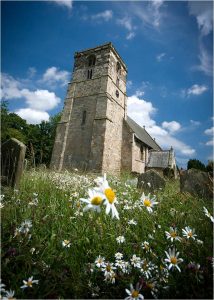The parish of Middleton-on-the-Wolds is situated in what was once the wapentake of Hartill, Bainton Beacon division, part of the historical East Riding of Yorkshire (see maps in Introduction). Its boundaries remained the same after the 1832 parish boundary changes. Towards the western end of the parish lie the remains of the medieval village of Kipling Cotes, which lends its name to the Kiplingcotes Derby. It is said to be the oldest horse race in England, having taken place every year (bar two) since 1519, over a course of four miles that extends over four parishes. Starting in the parish of Etton, it passes through the eastern extremity of Goodmanham and the western extremity of Lund, terminating not far from Kipling House farm in the parish of Middleton.
 |  |  |  1st left: trophy 2nd left: start post 3rd left: racecourse |
Before the Conquest there were five manors in Middleton. One was held by the archbishop of York and he remained tenant in chief in 1086, the lords being the canons of St. John, Beverley. Two others were held by King Edward and Gamal, son of Karli, and passed into the lordship of Nigel Fossard by 1086, and the remaining two held by King Edward and Aldgyth passed to Richard de Sourdeval. Count Robert of Mortain was tenant in chief of all four estates in 1086. Kipling Cotes must have been a village of some importance before the Conquest with its three manors, but all were deemed to be waste in 1086, when the archbishop of York, Count Robert de Mortain and William de Percy became their tenants in chief. Over the ensuing centuries Robert de Ros was one of the holders of the town of Middleton and, about 200 years before enclosure, it and a large portion of the land was in the hands of the Boyles, the Earls of Burlington. These passed through the marriage of an heiress to the Duke of Devonshire and, as in several neighbouring parishes, the Earls of Londesborough were the last to assume the title of lord of the manor.
Beside the town of Middleton itself, farms make up the only other centres of population in the parish. At enclosure in 1805 Eastfield farm and Kipling House farm were built at the eastern and western extremities. Middleton Wold House farm includes Middleton Wold Cottages, which were built for its labourers diagonally opposite the farm and on the other side of the road that crosses the parish. Since 1847 it has incorporated a Wesleyan Chapel (now disused). Nearby Horsewold farm was built in about 1810 for the rector. The rectory itself stood in parkland to south of the town of Middleton, later becoming Middleton Hall. In late 1941 it became the headquarters of the East Riding of Yorkshire Auxiliary Units, but probably remained empty from the end of the Second World War until its demolition in 1963. Only an early 19th century stable block survives in the grounds. The old manor house of Middleton used to stand opposite the Robin Hood pub before it too was demolished, leaving only the surrounding brick walls.
The church at Middleton is dedicated to St. Andrew. It was built of stone in the latter part of the Norman era, on the site of the earlier church that is mentioned in Domesday. It consists of an unusually long chancel built in the early 1200s, a nave that dates back to the 1300s, aisles, a south porch, and a three stage western tower, which in 1830 replaced the small octagonal turret and spire that had been built in the 1700s. The church underwent a thorough restoration in 1873, when the walls of the aisles and the tower were rebuilt, and the nave and chancel were reroofed. The old and interesting features were retained, including the 12th century font, the three sedilia and a Bronze Age urn, discovered locally, which is preserved in a special niche in the chancel arch. To the south of the church are four ancient tombstones. Three have incised crosses and the fourth, set on six small modern pillars, supports a human effigy, said to be the founder of the church. The stones were brought from Kipling Cotes and are believed to date from the 13th century.
There were many baptisms in Middleton of the members of the 4th generation of the Pickerings of Kilnwick 1. During the following generations the majority moved to neighbouring parishes but a handful stayed for another three generations.
It is interesting to note that the birth of James Handsley Puckering of the 12th generation of the Puckerings of Flamborough was recorded as Kipling Cotes in 1839. By then the village had long ceased to exist. His father was a farmer, so it is possible that he was born at Kipling House farm.
Sources:
Bulmer’s History, Topography and Directory of East Yorkshire with Hull 1892, pp. 240-242 and 404: https://specialcollections.le.ac.uk/digital/collection/p16445coll4/id/324025
History and Topography of Yorkshire, vol. 2, York, Ainsty, East Riding, pp. 514-515: https://books.google.fr/books?redir_esc=y&id=unEKAQAAMAAJ
The Buildings of England, York and the East Riding, pp.614-615: https://archive.org/details/yorkshireyorkeas0000pevs/page/614
Middleton-on-the-Wolds:
https://www.genuki.org.uk/big/eng/YKS/ERY/MiddletonOnTheWolds
https://intel-hub.eastriding.gov.uk/parish-profile/#/view-report/bd6a0cb7f85a46998f874a42bfd0dc8e/PP097
https://en.wikipedia.org/wiki/Middleton_on_the_Wolds
https://opendomesday.org/place/SE9449/middleton-on-the-wolds
Middleton Hall: https://www.staybehinds.com/location/middleton-hall-middleton-on-the-wolds-east-riding-yorkshire
Church of St. Andrew: https://historicengland.org.uk/listing/the-list/list-entry/1084151?section=official-list-entry
Group of four Monuments: https://historicengland.org.uk/listing/the-list/list-entry/1084152?section=official-list-entry
Kiplingcotes:
Cambridge Air Photos: https://www.cambridgeairphotos.com/location/rw33
https://opendomesday.org/place/SE9047/kipling-cotes
https://en.wikipedia.org/wiki/Kiplingcotes_Derby
https://www.youtube.com/watch?v=OFP4c-r_wOE




